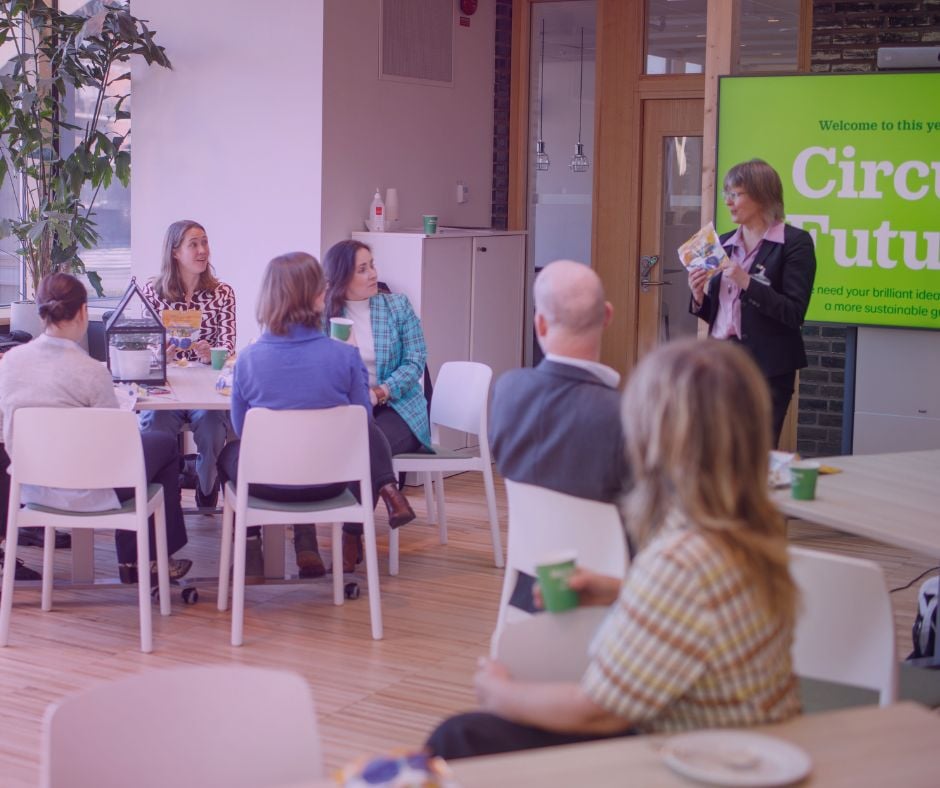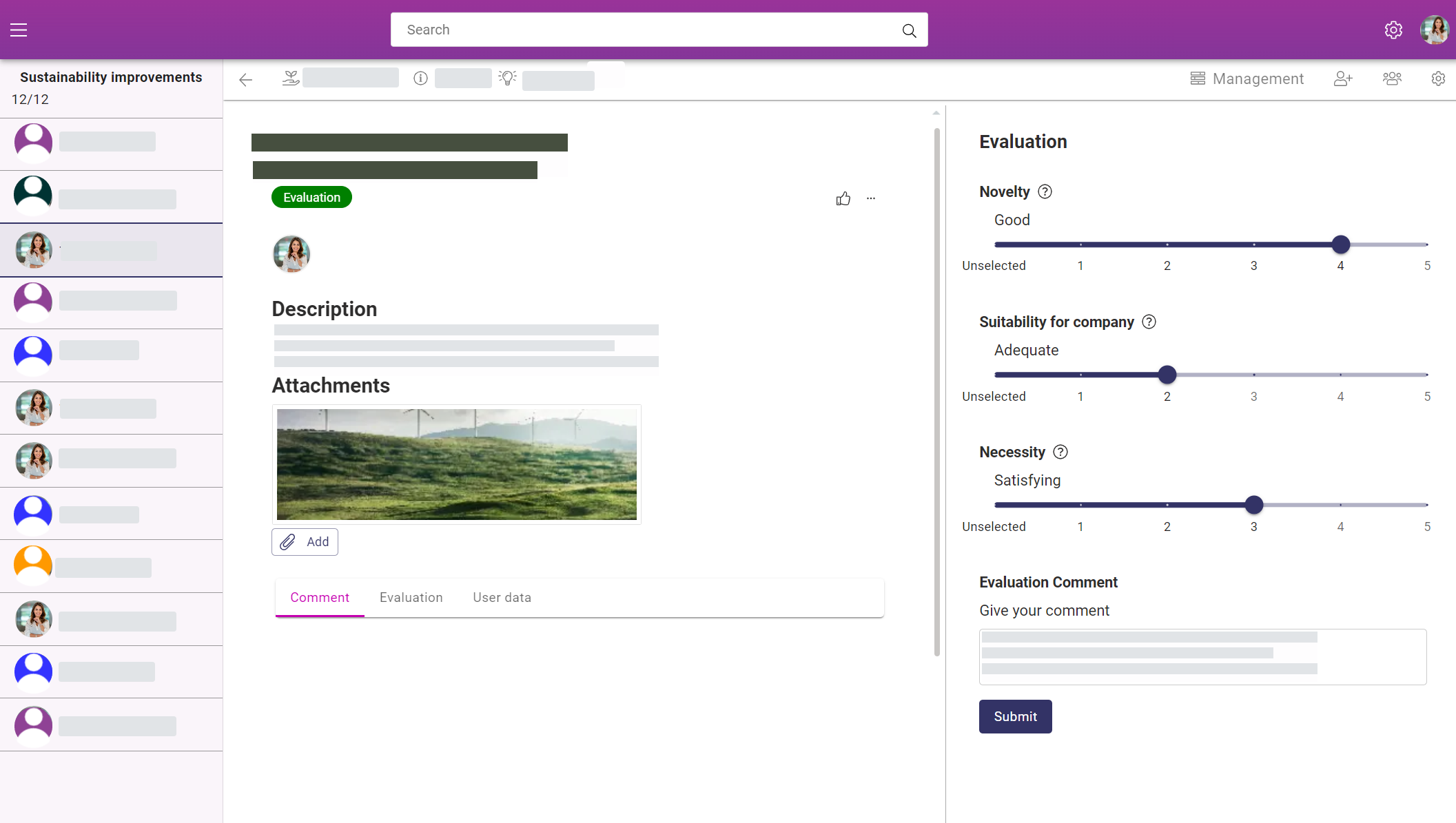Succeeding in innovation is crucial for the competitiveness of organizations of all sizes. Organizing innovation challenges (also known as innovation contest, innovation competition, idea contest and idea competition) is a widely used method for collecting innovative ideas that help companies reach their strategic goals.
Why some organizations can over and over again succeed in attracting contributors to participate in their challenges? Why some teams exceed their objectives consistently? What sets successful ones apart from mediocre ones? The answer is simple: thoughtful challenge design.
An effective innovation challenge attracts the right minds to work on a well-defined problem. Successful challenge design hits the mark in three core components: defining a suitable challenge question, brief and evaluation criteria. Let’s take a look at what latest trends in challenges are and how the best ones are designed.
Quest for new sources of ideas and insights
More and more organizations are turning their attention to new sources of ideas and insights to benefit their innovation processes. As the world becomes more complex, internal development departments rarely have all knowledge that is needed to create innovative solutions.
Getting contributions from a wide range of sources gives companies new perspectives and out-of-the-box ideas. This helps them overcome limitations in their own thinking, which often leads to better innovations. By interacting with people of diverse backgrounds and disciplines, companies get access to a wide range of different knowledge bases.
While arrangements such as R&D collaboration or innovation alliances are nothing new, organizations are moving towards involving a wide range of diverse contributors. With the help of IT tools and platforms, there are new ways to open up their innovation processes. Organizations can use crowdsourcing methods to reach out to large masses of users, employees, and partners and invite them to codevelop new solutions.
Crowdsourcing refers to broadcasting an open call to individuals with relevant expertise outside the organization to become involved in solving a specific challenge. It includes systems, for example, for idea submissions, innovation contests, hackathons, user design platforms, microtasking, and prototype evaluation.
Organizing innovation challenges is… well, challenging
When engaging in crowdsourcing organizations are faced with new issues. When innovating in-house, the understanding of what the innovation problem is about evolves simultaneously with the development of new solutions.
In crowdsourcing, the specification of a problem and finding a solution are detached from each other: when external solvers are asked to work on a problem, it can’t be easily changed or modified. Therefore, it’s crucial that the preparation is done thoroughly.
With a well-defined innovation problem that is formulated into a solvable challenge, others can direct their efforts in the right direction. Organizing crowdsourcing events, such as innovation contests, is also costly. Without a clear understanding of what is sought for, the efforts are in vain. Everyone knows that meetings without clear agendas are typically a waste of time. The same applies to ideation and problem-solving!
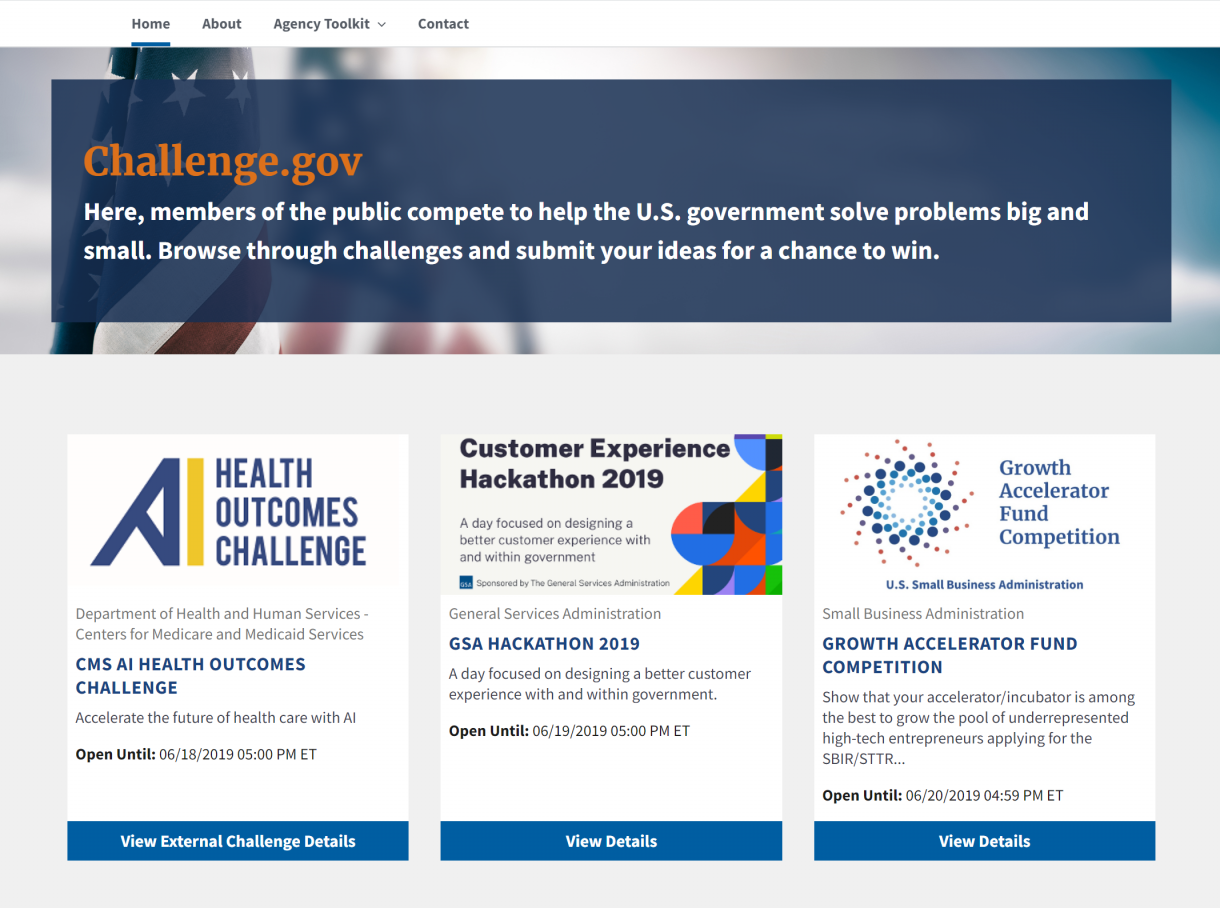
An illustrative example of the difficulties of challenge-driven innovation can be found in the United States where the government runs a software platform called Challenge.gov where different government agencies organize public innovation competitions. Since their launch in 2010, more than 825 competitions have been run, with over 250 000 participants and more than 250 million dollars in prize money offered.
Public managers have, however, been faced with the realization that specifying problem statements for the competition is extremely difficult (see Desouza, 2012). Many times, they’ve found out that the competitions haven’t achieved their objectives because they didn’t define their wishes in enough detail. With too broad problem statements, the problem solvers have a hard time figuring out what it is that the organizer actually wants.
The result of poor problem specification is that the participants lose their motivation for contributing to competitions when they learn that their work isn’t implemented. Combined with the organizers’ inflated expectations of what can be achieved by a single competition may generate disappointments on both sides.
The example of Challenge.gov brings attention to different aspects of managing projects like this.
- First, managers need to identify relevant innovation problems in their organization. Often the problems that need solving the most are, however, highly complex. A common mistake is to post so-called “Holy Grail” problems: complex, difficult, and commercially highly valuable. A downside of these problems is that they are almost impossible for others to solve – or even understand. Complex problems may need to be simplified or separated into multiple parts to make them work.
- Second, the problems need to be formulated into challenges with proper briefing and materials. Since the potential solvers may come from different backgrounds and have diverse knowledge bases, here lies a danger of not finding an effective way of presenting the problem. Overly technical descriptions are not accessible to many participants and the problems may need to be translated into more widely understandable forms. This, however, requires a lot of effort since there is a risk of misinterpreting the issues when trying to put them in layman’s terms.
- Third, a suitable target crowd needs to be identified and incentivized. Depending on the topic, suitable crowds may consist of individuals with similar profiles. If solving a problem requires very specific expertise, choosing participants based on, for example, their profession is a good strategy. In contrast, when the goal is to collect a wide range of ideas and insights, a highly diverse crowd works better. In all cases, the participants’ motivation needs to be considered. Motivations can be intrinsic, such as enjoyment, attachment to a community or issue, or an opportunity to express individual creativity. Alternatively, they can be extrinsic and dependent on monetary rewards, reputational benefits, or self-marketing opportunities. In both situations, it’s important to try to understand what drives the participants and how to make them put the effort into participating.
- Finally, organizations need to be able to evaluate the contributions. Clear and specific evaluation criteria don’t just help managers identify the top contributions but also direct the participants to provide the right kind of solutions. Often – especially when the number of contributions is high –the evaluation process is more demanding than expected and ensuring sufficient time and resources for it is a priority. The nature of the topic should determine who is involved in the evaluation. For technical topics, a sufficient level of technical expertise is needed of the evaluators. Often it is also worth including individuals with other expertise, e.g. a business mindset or understanding of sustainability issues, to gain a more comprehensive understanding of the value of a solution. Especially, when the project addresses systemic issues with high social importance, it is worth considering bringing in external experts to choose the best ideas.

Common problems in designing innovation challenges
Specifying the innovation problem, the topic of the challenge is probably the single most important decision affecting the success or failure of the project. Based on a wide experience in organizing and facilitating various kinds of campaigns, we have identified three typical problems that organizations often stumble with:
- Too broad framing
- Too focused framing
- Ambiguous framing
Next, we will dive deeper into each of these problems.
Problem 1: Too broad framing
Having a very broad framing such as “How might we prevent the sea level from rising?” can be very good if the organizers are looking for radical ideas and are honestly open to all possible solutions to this severe problem. However, most organizations have certain limitations such as technological capabilities, available resources, business strategy etc. If such limitations exist, they are likely to constraint which ideas can be implemented. Therefore, those constraints should be included also in the specification so that no resources are wasted to develop ideas that don’t have a chance to be implemented.
Ideas resulting from too broad framing are often very laborious to evaluate as they are so different from each other that it is difficult to find suitable metrics. Instead, methods such as return-on-investment calculations must be applied individually for each idea. Broad framing makes it also more difficult to combine ideas into larger concepts as their contents and scope may be highly diverse
Problem 2: Too focused framing
Having a very focused framing like “How might we prevent sea level from rising through decreasing CO2 emissions with solar power?” will result ideas which are much closer to each other and easier to combine into larger concepts. However, being too restrictive may make the participants feel that restrained by all limitations. The risk for the topic owner is that some great solutions are not submitted if they do not fit the scope.
Problem 3: Ambiguous framing
Including the word “and” in the challenge question often creates problems and it is important to make sure that it is used in the right way. The effective way is to introduce constraints for ideation. Excluding obvious solutions can be a very powerful way to drive results, for example, “How might we create an effective marketing campaign and not use money for it?” could be very effective. On the other hand, a question like “How might we prevent sea level from rising and animal species from becoming extinct?” is not very powerful. It will make it difficult for the contributors to focus their ideation and result in a low number of contributions. In this case, it would be more effective to split the topic and run two separate campaigns.
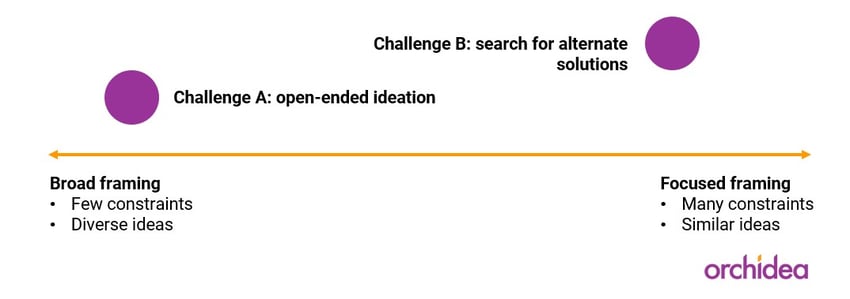
Tips for better challenge design
The first step in framing is to set the objectives for the project. Almost without an exception, the primary objective is to develop innovative solutions. In internal crowdsourcing, often almost as important secondary objective is to drive cultural change in the organization towards being more innovative and participatory. Similarly, involving external stakeholders may be a way of strengthening relationships with them. Keeping all defined objectives in mind when framing the topic is important.
Often organizations that are new to running innovation competitions tend to have too broad framing which results in ideas, which are not feasible and relevant for the organization. This contrasts the fact that when introducing innovation contests for the first time, especially in internal crowdsourcing, organizations typically want to make the participation as easy as possible. The rule of thumb for the first campaigns is to have focused framing because it increases the likelihood of receiving feasible ideas. Feasible ideas are in turn more likely to be implemented, which motivates the participants to contribute again in the future.
Challenge question formation
The basic form of a challenge question (see Nolan, 2015) is
How might we [verb] [desired result]?
For example
How might we prevent the sea level from rising?
By changing the [desired result], different results can be achieved. One way to work on the definition of the [desired results] is to specify means and ends: how and what for new solutions are sought for? An example of question formation with a focus on means is:
How might we prevent the sea level from rising with green energy sources?
In comparison a question focusing on the ends is:
How might we protect people from the climate change?
A technique for developing question alternatives is asking “Why” after forming the first question. The answers to the “Why” questions are turned into new questions which can be further developed with new “Whys”.
Question 1: How might we prevent the sea level from rising?
Why?
Answer 1: Because rising sea level will cause widespread coastal flooding.
Question 2: How might we prevent widespread coastal flooding?
Why?
Answer 2: Because coastal flooding threats ten per cent of the world’s population that live in areas are less than meters above sea level.
Question 3: How might we attract the people living in the low-lying coastal areas to move higher-lying areas?
Etc.
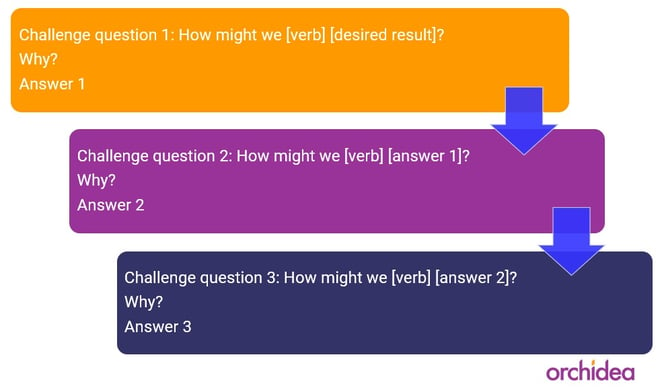
Alternative way to develop the question is to ask, “What is stopping us?”. The answer can then be turned into a new question like in the “Why?” example. Several rounds of asking “What is stopping us?” then provide more alternatives.
Envisioning possible solutions
Too often the team that designs the framing forgets to envision what kind of ideas their contest would potentially generate. Especially if the team is familiar with the participants it is easy to imagine likely idea types. If this envisioning exercise will generate idea types that are not desired, it is better to modify the framing accordingly.
Once a few good question candidates have been developed it is time to envision what kind of ideas one would expect to get as response to them. If the expectation is that most of the ideas would be suitable, but there is a small sector of ideas that are not desired or feasible, it is often easiest to keep the question and address this undesired sector in the brief.
Preparing a challenge brief
Far too often people think that the design equals formulating a question to be answered. Question formation is certainly the most important aspect in specifying a topic, but it is not sufficient alone. To make a topic truly understandable, it needs to be complemented with a brief and evaluation criteria.
Typically, the brief includes:
- information about the topic background and sponsor
- how the topic links to the strategy and objectives of the organizer
- what customer problem is being solved
- what is already known about the topic
- what types of ideas are desired: e.g. products, services, business models, technologies, processes
- idea types that are undesired
- idea management process: e.g. steps, timeline, feedback, rewarding
- evaluation criteria
Adding background information like market research and competitive information may improve the understanding of the participants. On the other hand, it is always good to remember that providing too much information can start to limit the thinking of the participants.
At this point, we hope that designing a successful innovation challenge does not feel like a daunting task. Rather, we hope you are ready to start it and come up with projects that meet and exceed your goals. And maybe you have some tricks of your own. Let us know. We are eager to learn from them!
If you're interested to learn more about running an innovation challenge, I recommend you read the articles: How to Run an Innovation Challenge? - Step-by-Step Guide and Innovation challenge - the complete guide.
About the authors
Matti Pihlajamaa is a Senior Scientist at VTT with a doctoral degree in innovation management. He has studied how companies seize the opportunities from open innovation and digitalization. Matti has investigated innovation challenge design in a recent research project SHARE.
Jouni Halme is Sales Director of Orchidea Innovations which is a leading Nordic software company focusing on innovation management. Jouni has also written the blog post: Innovation definition, strategy and process.






